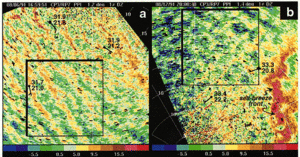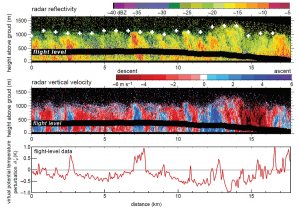Those kinds of storms are the most difficult to predict since there aren't distinct mesoscale features like boundaries to trigger storms, and it comes down to small-scale processes. Take a look at this image produced by a highly sensitive radar (on NEXRAD you'd see very little) where the large box is. Areas of weak colors are probably downward motion (relatively clear air from aloft sinking), and areas with strong colors are where it's rising, with thermals bringing scatterers of radar energy (often bugs and perhaps small bits of debris picked up by the wind) to higher levels. All of this is moving with the mean winds, too. The atmospheric motion on a sunny summer day in your county looks a lot like what these images show. So this gives you some idea of the difficulty predicting exactly where a storm is most likely to might pop up.
View attachment 15448
So it pretty much comes down to the basics... you look at all the available data and try to find where there's the highest dewpoints and temperature, where there's the best convergence of the wind field, and the most favorable, uncapped conditions aloft. You'd look for any boundaries left over from yesterday's storms... that's a very important clue. Hand analysis, careful use of radar overnight, and high-res visible satellite images really help here (and this is where GOES-16 really shines). And you would consider interaction of the atmosphere with local topography, like the Caprock if you're a Lubbock forecaster. In tropical climates, storms often prefer to form over rivers and marshland instead of boundaries, as that's where the fuel is. If you want, you can look at high resolution models
like this 3 km NAM run. But this would be mostly for fun... the models just can't handle the smallest scale details because the average surface observation spacing in the US is about 50 miles every 20 minutes, which kind of puts a practical limit on how precise these forecasts can be.
Now once these "air mass" storms are underway, you can sometimes get an idea where new storms will pop up by anticipating the location and movement of boundaries and updraft towers relative to the first storm. Where the mean low-level wind flow impinges on the outflow boundary is a favored area for additional development. But if the air mass is relatively uncapped, which is common in the middle of summer, new storms just develop randomly along the outflow and soon you're looking at 20 or 30 cells.


